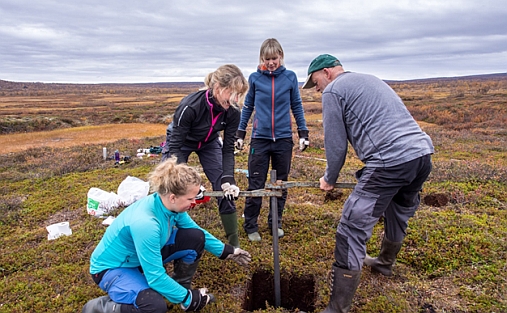About the project
The research project PERMANOR – "Permafrost landscapes in transformation - from local-scale processes to the global model NorESM" aims at increasing our knowledge on the role of permafrost in the global climate system. Permafrost soils contain large amounts of organic material that is protected from microbial decomposition in the frozen ground, similar to a gigantic freezer.
In a future warmer world, thawing of permafrost is expected to occur, so that this organic material could be partially decomposed and trigger a massive release of greenhouse to the atmosphere. The additional warming potential of this so-called “permafrost-carbon feedback” is so far not well captured in Earth System Models (ESMs) used for climate predictions, including the Norwegian Earth System Model NorESM.
Objectives
The project brings together experts from the Department of Geociences, University of Oslo, the Bjerknes Centre for Climate Research, Bergen and the German Alfred-Wegener-Institute for Polar and Marine Research to investigate the highly dynamic evolution of permafrost landscapes in the light of ESM development. Rapid changes of permafrost landscapes are in many cases related to thawing ice-rich ground which can for instance transform dry and well-drained permafrost ground into a wetland within only a few years, as currently observed in mire areas in Northern Norway.
In PERMANOR, we will make use of extensive field observations in Norway, Svalbard and Siberia to better include such processes in NorESM climate simulations. The improved representation of permafrost landscape dynamics in NorESM will lead to reducing our uncertainty in the predictability of future climate change.
Outcomes
In autumn 2016 we conducted a joint fieldwork in Finnmark with meteorologists and climate modelers both from the University of Oslo and the Bjerknes Centre to experience the “real” permafrost landscapes which must be represented in large-scale model schemes in order to predict the magnitude of the permafrost-carbon feedback. Together with our project partner Britta Sannel from Stockholm University, we obtained cores and samples from up to 3m depth in several peat plateaus.
Thick layers of almost pure ice were documented which upon melting would lead to ground subsidence or even the formation of ponds. Not only the field datasets, but also the personal experience of the participants will in the future guide model development within the PERMANOR project.
Background
The project is cross discplinary with researchers in geography and in meteorology. Participants from two sections at the Department of Geosciences, and other research institutions.
Financing
The full name of the project are Permafrost landscapes in transformation - from local-scale processes to the global model NorESM (PERMANOR). The project is funded through the Norwegian Research Council KLIMAFORSK program, and have the NFR project number 255331.
The PERMANOR project started up i 2016 and will be finished in 2020.
Cooperation
This project is carried out in cooperation with several researchers from different institutions, see links in right column for participating researchers:
- Department of Geosciences, University of Oslo
- Bjerknes Centre for Climate Research, Bergen, Norway
- Alfred-Wegener Institute for Polar and Marine Research, Potsdam, Germany
- Department Natural Geography, Stockholm University
